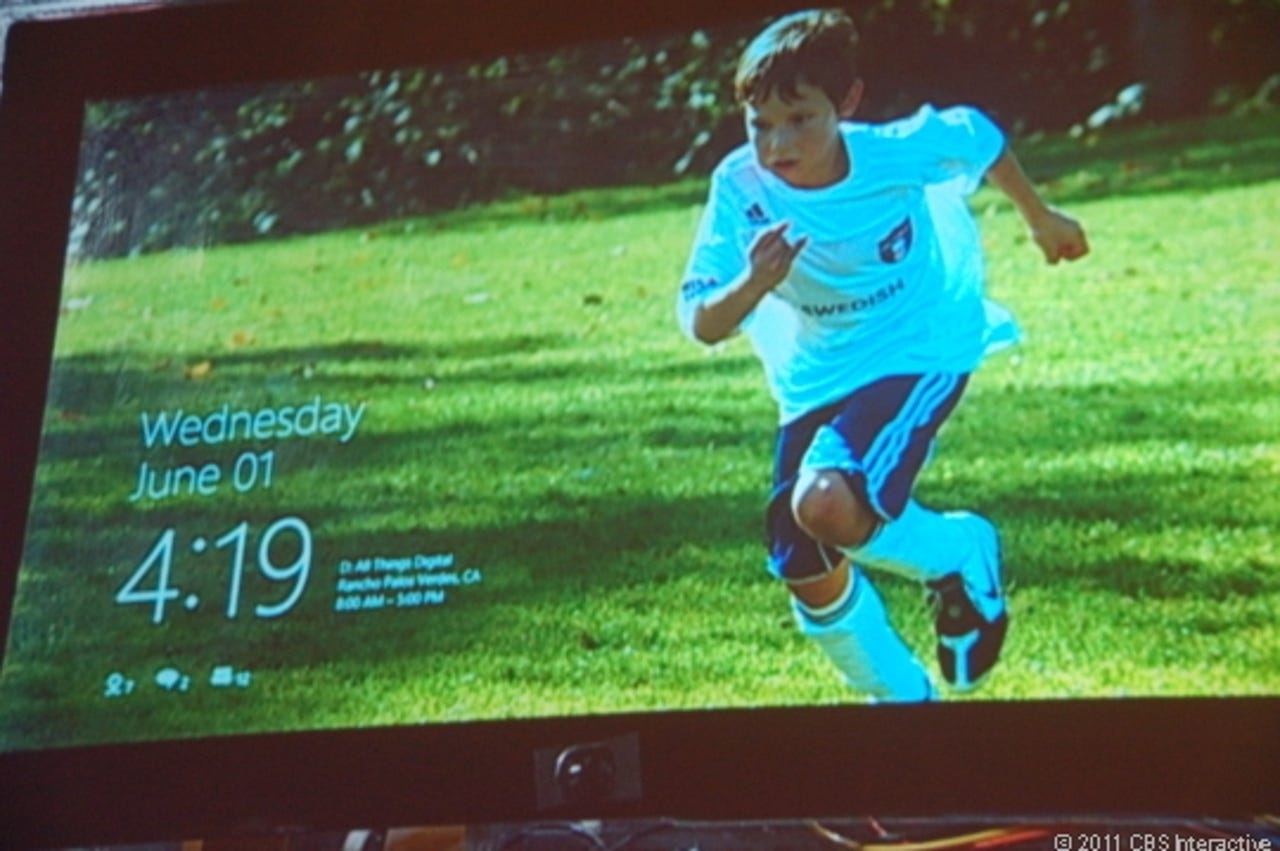Photos: Windows 8, Apple iCloud, Nokia N9, tablets and space exploration


Windows 8
Photos of the month - June 2011
It seems like just a few months ago we were reporting on the launch of Windows 7. But time and operating systems wait for no man, and this June Microsoft gave us the first look at Windows 7's successor, cunningly codenamed Windows 8.
According to Microsoft, Windows 8 will work on laptops, desktops and tablets, and will run on any computer that currently runs Windows 7.
Pictured above is Windows 8's start-up screen, showing how the image of the screen can be personalised.
To see more of Windows 8 in action, check out Windows 8 - Microsoft's future OS close-up.
Microsoft Office 365
Windows 8 wasn't the only Microsoft news in town last month. June also marked the official launch of Office 365, Microsoft's cloud version of its office productivity suite.
After being made available as a public beta this April, Microsoft announced on 28 June that Office 365 is on general release.
Among the features Office 365 offers is the ability to create a public-facing website with hundreds of different themes.
To see what else the cloud suite can do, see Office 365 - Microsoft's cloud suite finally in the wild.
Apple iOS 5 Notification Centre
And it wasn't just Microsoft announcing new offerings in June. At Apple's annual Worldwide Developers Conference (WWDC), held last month, the Mac maker took the wraps off a number of products including the latest version of the operating system for the iPad, iPhone and iPod, known as iOS 5.
Among the features new to the OS in its fifth iteration is Notification Center, a hub for notifications - such as missed calls and text messages - on the device. Users can also see a rundown of all their messages on the lock screen, including missed calls and app updates.
To see what other features have made it into iOS 5, check out Apple's fresh OS for iPhone and iPad - iOS 5.
Apple iCloud launched by Steve Jobs
Also unveiled at Apple's WWDC was iCloud, Apple's cloud services offering for remotely storing and updating content across multiple Apple devices - iPhone, iPad and iPod touch - as well as Mac and PC desktops.
iCloud will take over the syncing of mail, contacts and calendars over multiple iOS devices, as well as ensuring content bought from Apple - books or music, for example - on one device is automatically pushed out to others.
For more, see Apple iCloud - the services, the features and what you get for free.
iOS X Lion's conversation threading in Apple Mail 5
Rounding out the product announcements made at WWDC was the launch of the latest operating system for Macs, known as Lion.
As well as the introduction of full-screen apps, Launchpad - an overview of the apps running on your Mac - and easier server set-up, Lion has gained a conversation thread format similar to Gmail's for Apple Mail 5, shown above.
For a full tour of the OS, see A safari through Apple's Lion OS for Mac.
Apple's Final Cut Pro x
But that wasn't it for Apple product announcements in June - oh no. Apple was still to launch the latest version of its professional video-editing software, Final Cut Pro X.
The new Auditions feature in Final Cut Pro X lets users see how edits they've picked out work with the rest of a sequence. Users can select multiple clips for audition, then try each one out to see how it fits in, eventually picking the best one without having to rejig the work each time.
For the full hands-on with the video-editing software, see Apple pushes play on Final Cut Pro X.
Apple campus
Continuing the Apple theme running through June's photo stories, the Mac maker last month took the wraps off plans for a new campus.
The proposed headquarters, which has been compared to a flying saucer, will play host to 12,000 Apple employees and be situated in the company's home of Cupertino.
For a closer look at the HQ, see Space base - Apple's new HQ comes with a sci-fi flavour.
Acoustic chamber at Estec's test centre
From Apple's flying saucer to actual space exploration, silicon.com's sister site CNET went to take a look at the European Space Research and Technology Centre (Estec).
Pictured above is the acoustic chamber at Estec's test centre. It is employed to reproduce the noise made by rockets in order to evaluate whether satellites or other space-bound specimen can survive the intense sounds of a launch.
For a closer look at Estec's space research, see It really is rocket science inside the European Space Agency's test centre.
Photo: Daniel Terdiman/CNET
The Tunny machine at the National Museum of Computing
From space travel to time travel. In June, we took a look at the work of computing enthusiasts who have rebuilt a machine that helped crack the codes used by the Nazi high command during World War II.
This is a close-up of the Tunny machine, which is housed at the National Museum of Computing in Buckinghamshire.
See more shots of the fully functional code-cracking machine at WWII machine that cracked Nazi codes is reborn.
Open University Pervasive Interaction Lab tour
Some fascinating research came under the silicon.com microscope last month as senior reporter Natasha Lomas took a tour of the Open University's Pervasive Interaction Lab, which explores human computer interaction and how technology can shape and influence behaviour.
Pictured above is one of its projects called MusicJacket - which uses motion sensors and vibrotactile feedback to help a violin student adopt the correct posture and bow motion.
To learn more of the lab's research projects, see Can tech change your behaviour? The Open University investigates.
AVG threat map
Research of a different kind is being carried out at antivirus company AVG's lab in Brno, in the Czech Republic.
While AVG wouldn't let silicon.com's sister site CNET show you screenshots of precisely how they take down a virus, here's the threat map their analysts see.
To see what else goes on inside an antivirus lab, check out Restricted area - behind the scenes at AVG's virus lab.
QR codes at the Urban Physic Garden
silicon.com took its camera to the Urban Physic Garden in Southwark, where QR codes are also in bloom.
The garden makes use of the codes to share information on the plants. After snapping the code with a smartphone camera, visitors can see details of the species on their phones.
To see the garden in all its glory, check out QR codes, herbal medicine and ping pong? Welcome to the Urban Physic Garden.
Jos Creese CIO50
June was also the month silicon.com unveiled the fifth annual CIO50 list of the UK's most innovative and influential heads of IT.
The list was unveiled at an exclusive champagne reception and CIO networking event in central London, attended by this year's CIO50 winner, Jos Creese, CIO of Hampshire County Council, pictured above chatting to fellow attendees.
For more photos from the night, see The unveiling of the CIO50 2011.
Windows Phone 7.5 Mango
Mobile software made an appearance on silicon.com last month as we took a closer look at the Windows Phone 7.5 operating system, known as Mango.
In Mango, Microsoft has made switching between open apps easier. Users now just need to press and hold the Back button below the screen - faded in this shot.
For more details on the OS, see The juice on Windows Phone Mango - what's inside Microsoft's mobile OS update?
Nokia N9
From mobile software to hardware, as Nokia announced the launch of the N9.
The smartphone is the first and probably only device Nokia will make runing the MeeGo operating system, after committing its OS future to Microsoft's Windows Phone 7 earlier this year.
For a full look at the device and its specs, see Nokia unveils N9 - its first MeeGo smartphone.
Hampshire Fire and Rescue Service using tablets
Mobile hardware also came in to play as Hampshire Fire and Rescue Service showed off some of the tablet computers it is using to better prepare firefighters for tackling blazes and other call-outs.
Firefighters in the service use terminals to pinpoint the location of fires and other incidents, and to learn about potential hazards - such as gas cannisters near a blaze or information on a chemical that has been spilled.
Pictured is a firefighter using mapping software on a mobile data terminal, which allows the crew to access information on the location of ongoing incidents.
To find out more about how Hampshire uses tablet technology to help it tackle fires, check out Fighting fire with tablet technology.
HP TouchPad tablet
Tablets also featured on silicon.com last month when editor Steve Ranger got a hands-on with HP's soon-to-launch TouchPad device.
The TouchPad tablet runs the Linux-based webOS and is aimed squarely at the business market.
For more on the TouchPad, as well as the Palm3 smartphone, see HP TouchPad tablet turns up the enterprise heat on Apple's iPad.
RBS Marketplace PlayBook app
Also last month, investment bank RBS showed off the next iteration of its RBS Marketplace app for the BlackBerry PlayBook - pictured above - which puts personalised research data at the fingertips of its customers. The bank reckons tablets are a better device for reading this data than smartphones as research articles can be hundreds of pages long, making the slate's bigger screen a boon.
The updated app includes a Trends view feature which lets users see at a glance what other RBS customers have been reading and thereby judge whether an article is worth their time.
For more on RBS' updated PlayBook app, see RBS Marketplace app for BlackBerry's PlayBook tablet.
British Library iPad app
Tablet apps also cropped up as silicon.com looked at how the British Library is bringing classic books and lost treasures from the 19th century to the Apple iPad.
The British Library app will provide access to digitised versions of more than 60,000 books, complete with illustrations and sketches, with titles including classics such as Mary Shelley's Frankenstein and The Adventures of Oliver Twist by Charles Dickens.
This is an illustration from Excursions in Madeira and Porto Santo. The book charts the story of a voyage to Africa by Thomas Edward Bowdich in 1823.
Check out more classic 18th-century books from the app by visiting Want the British Library on your iPad? There's an app for that.